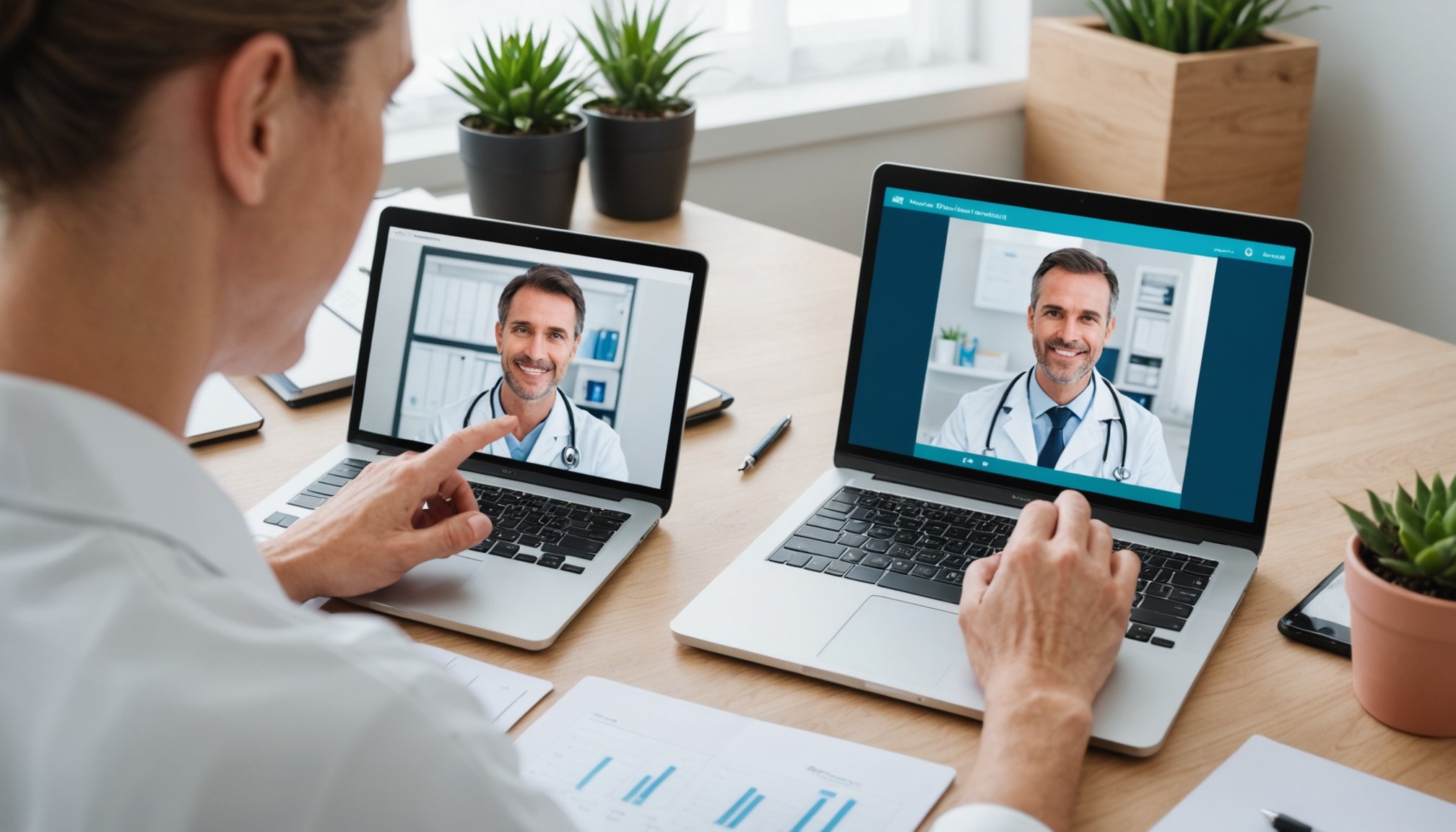Unlocking the Potential of Telemedicine for Effective Management of Chronic Skin Disorders
The Rise of Telemedicine in Healthcare
In recent years, the healthcare landscape has undergone a significant transformation, particularly with the advent of telemedicine. This shift has been accelerated by the COVID pandemic, which highlighted the need for remote healthcare services. Telemedicine, a subset of telehealth, has emerged as a vital tool in managing various health conditions, including chronic skin disorders. Here, we delve into how telemedicine is revolutionizing the management of skin diseases and what the future holds for this innovative approach.
What is Teledermatology?
Teledermatology is the practice of dermatology through telecommunication technology, allowing patients to receive dermatological care remotely. This can include video consultations, image-based diagnoses, and remote monitoring. The global teledermatology market is projected to grow significantly, from USD 10.85 billion in 2023 to USD 55.17 billion by 2031, at a CAGR of 22.73%.
Also to discover : Unlocking Healing: The Impact of Narrative Therapy on Veterans Battling PTSD
Benefits of Teledermatology
Increased Access to Care
One of the most significant advantages of teledermatology is its ability to increase access to healthcare, particularly for patients in remote or underserved areas. With telemedicine, patients can consult dermatologists without the need for physical visits, reducing wait times and improving patient participation dramatically.
- Reduced wait times for consultations
- Increased accessibility for rural or underserved populations
- Cost-effective compared to traditional in-person visits
- Enhanced patient engagement and adherence to treatment plans
Improved Patient Outcomes
Teledermatology also enhances patient outcomes by enabling early detection and treatment of skin conditions. For instance, remote consultations can facilitate timely diagnoses of skin cancers, which are critical for effective treatment.
Also to see : Unlocking the Advantages of Deep Pressure Stimulation for People with Autism: A Comprehensive Guide
- Early detection of skin cancers and other conditions
- Real-time monitoring and adjustment of treatment plans
- Better management of chronic conditions like psoriasis and eczema
- Reduced need for hospitalizations due to complications
Technological Advancements in Teledermatology
Role of Artificial Intelligence and Deep Learning
Artificial intelligence (AI) and deep learning are playing increasingly important roles in teledermatology. These technologies enable the analysis of large volumes of data, including images, to aid in diagnoses.
- AI-powered algorithms for image analysis and disease detection
- Deep learning models for predicting disease progression and treatment outcomes
- Integration with electronic health records (EHRs) for comprehensive patient data
For example, AI can be used to analyze dermatological images to identify skin lesions and predict the likelihood of skin cancer. This not only aids in early detection but also reduces the workload on healthcare professionals, allowing them to focus on more complex cases.
Remote Patient Monitoring (RPM)
Remote patient monitoring is another crucial aspect of teledermatology. RPM involves the use of digital medical devices to track patients’ vital signs and health metrics in real time.
- Continuous monitoring of vital signs such as heart rate and blood pressure
- Real-time data transmission to healthcare providers
- Early intervention based on changes in patient data
- Enhanced patient engagement through self-monitoring tools
A study on remote monitoring highlighted that this approach can significantly reduce hospital readmissions and improve patient outcomes by allowing clinicians to intervene early based on real-time data.
Clinical Applications and Examples
Telehealth Platforms
Several telehealth platforms have been developed to facilitate teledermatology services. For instance, Teladoc Health introduced a comprehensive digital application that integrates various healthcare services, including teledermatology, under a single platform.
- Integrated platforms for video consultations and image-based diagnoses
- Secure and HIPAA-compliant data transmission
- User-friendly interfaces for patients and healthcare providers
- Seamless coordination between different healthcare services
Case Study: Arizona Agency’s Omnichannel Approach
An Arizona agency has implemented an omnichannel approach to home health, which includes telehealth and RPM. This approach allows patients to start with a telehealth consultation and seamlessly transition to in-person house calls or clinic visits if necessary.
- Hybrid approach combining telehealth, RPM, and in-person care
- Use of MedWand technology for remote house calls with clinical-grade data
- Integration of medical assistants for patient support
- Focus on patient convenience and flexibility
Challenges and Future Directions
Data Accuracy and Confidentiality
One of the significant challenges in teledermatology is ensuring the accuracy and confidentiality of patient data. This includes the need for robust data security measures and the education of clinicians on the differences between hospital and home monitoring data.
- Ensuring data security and compliance with regulatory standards
- Educating clinicians on interpreting home monitoring data
- Addressing gaps in continuous data from home settings
- Building patient confidence in the technology
Regulatory Frameworks
The regulatory landscape for telemedicine is evolving, with a focus on ensuring the safety and efficacy of remote healthcare services. For example, the FDA has approved certain wearables for monitoring heart failure patients, but more large-scale studies are needed to fully understand their benefits.
- Regulatory clearance for medical devices
- Need for large-scale clinical trials to validate technology
- Ensuring equitable access to technology for all patients
- Addressing the cost and availability of specialized devices
Practical Insights and Actionable Advice
For Patients
- Engage with Technology: Take advantage of telehealth services to manage your skin conditions. Regularly use RPM devices to monitor your health and stay connected with your healthcare providers.
- Educate Yourself: Understand the benefits and limitations of teledermatology. Learn how to use the technology effectively and maintain good digital hygiene.
- Follow Treatment Plans: Adhere to the treatment plans recommended by your healthcare providers. Regular follow-ups and adjustments can significantly improve your outcomes.
For Healthcare Providers
- Stay Updated: Continuously update your knowledge on the latest technologies and best practices in teledermatology.
- Patient Education: Educate your patients on the use of telehealth services and RPM devices. Build their confidence in the technology.
- Collaboration: Collaborate with other healthcare professionals to ensure seamless care transitions and comprehensive patient management.
Teledermatology is revolutionizing the management of chronic skin disorders by providing accessible, cost-effective, and high-quality care. As technology continues to advance, it is crucial to address the challenges and ensure that these innovations benefit all patients. By leveraging AI, deep learning, and RPM, we can enhance patient outcomes and transform the way we deliver healthcare.
- Teledermatology is here to stay and will continue to grow.
- It offers numerous benefits, including increased access and improved patient outcomes.
- Addressing challenges such as data accuracy and regulatory frameworks is essential.
- Continuous education and collaboration are key to maximizing the potential of telemedicine.
In the words of a healthcare professional, “Telemedicine fits into our larger omnichannel strategy by expanding access to care and providing patients with more choices. It allows us to meet patients where they are, whether that’s through a video consultation, RPM, or an in-person visit”.
As we move forward, it is clear that telemedicine will play a pivotal role in the future of healthcare delivery, especially in the management of chronic skin disorders. By embracing this technology and addressing its challenges, we can create a more accessible, efficient, and patient-centered healthcare system.











